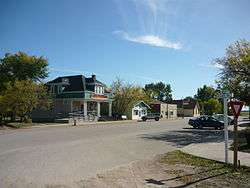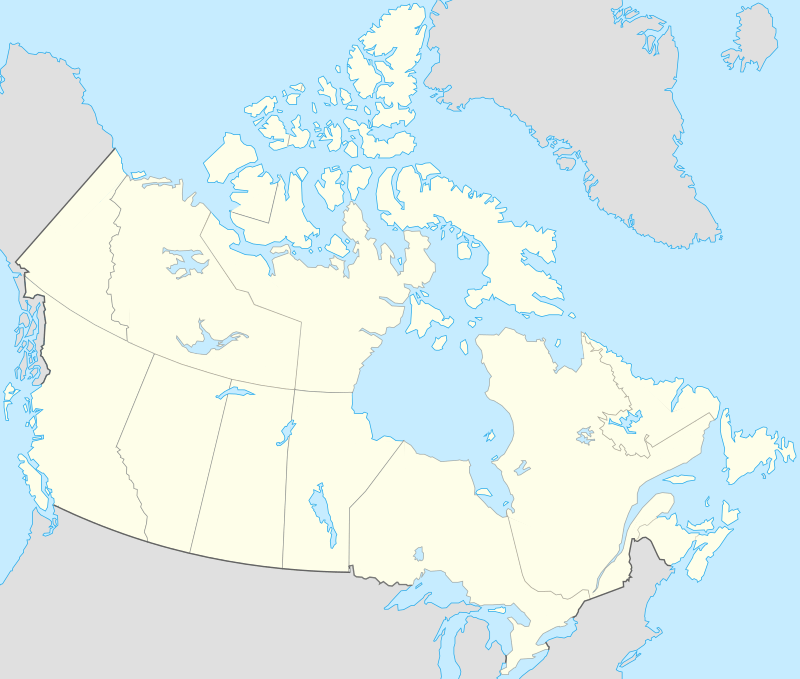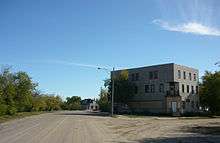Radisson, Saskatchewan
Radisson is a town in the province of Saskatchewan, Canada. It was named after Pierre-Esprit Radisson (1636–1710), an explorer who was instrumental in the creation of Hudson's Bay Company.
Radisson | |
|---|---|
Town | |
 Main Street | |
 Radisson  Radisson | |
| Coordinates: 52°27′47″N 107°23′20″W | |
| Country | Canada |
| Province | Saskatchewan |
| Region | Saskatchewan |
| Census division | 16 |
| Founded | 1905 |
| Incorporated (Village) | 1906 |
| Incorporated (Town) | 1913 |
| Government | |
| • Mayor | Leona Bennett |
| • Governing body | Radisson Town Council |
| Area | |
| • Total | 2.07 km2 (0.80 sq mi) |
| Elevation | 525 m (1,722 ft) |
| Population (2011)[1] | |
| • Total | 505 |
| • Density | 243.6/km2 (631/sq mi) |
| Time zone | CST |
| Postal code | S0K 3L0 |
| Area code(s) | 306 |
| Highways | Highway 16 Highway 340 |
| Website | radisson |
| [2][3] | |
Demographics
| Canada census – Radisson, Saskatchewan community profile | |||
|---|---|---|---|
| 2011 | 2006 | ||
| Population: | 505 (20.0% from 2006) | 421 (5.0% from 2001) | |
| Land area: | 2.07 km2 (0.80 sq mi) | 2.07 km2 (0.80 sq mi) | |
| Population density: | 243.6/km2 (631/sq mi) | 203.1/km2 (526/sq mi) | |
| Median age: | 46.9 (M: 47.3, F: 46.6) | 47.5 (M: 47.5, F: 47.5) | |
| Total private dwellings: | 257 | 228 | |
| Median household income: | $40,778 | ||
| References: 2011[4] 2006[5] earlier[6] | |||
Transportation
The community is served by Radisson Airport which is located adjacent to Radisson.
Climate
| Climate data for Radisson | |||||||||||||
|---|---|---|---|---|---|---|---|---|---|---|---|---|---|
| Month | Jan | Feb | Mar | Apr | May | Jun | Jul | Aug | Sep | Oct | Nov | Dec | Year |
| Record high °C (°F) | 9 (48) |
12 (54) |
19 (66) |
30.5 (86.9) |
36 (97) |
41 (106) |
37.5 (99.5) |
38 (100) |
35.6 (96.1) |
30 (86) |
17.2 (63.0) |
9 (48) |
41 (106) |
| Average high °C (°F) | −10.7 (12.7) |
−8.1 (17.4) |
0.6 (33.1) |
10.3 (50.5) |
19.3 (66.7) |
23.3 (73.9) |
25.1 (77.2) |
24.1 (75.4) |
18.1 (64.6) |
11.1 (52.0) |
−2.1 (28.2) |
−10.1 (13.8) |
8.5 (47.3) |
| Daily mean °C (°F) | −15.9 (3.4) |
−13.5 (7.7) |
−4.8 (23.4) |
4.4 (39.9) |
11.7 (53.1) |
16 (61) |
17.9 (64.2) |
16.6 (61.9) |
10.9 (51.6) |
4.5 (40.1) |
−6.8 (19.8) |
−15 (5) |
2.2 (36.0) |
| Average low °C (°F) | −21.2 (−6.2) |
−18.9 (−2.0) |
−10.3 (13.5) |
−2.5 (27.5) |
4.1 (39.4) |
8.6 (47.5) |
10.6 (51.1) |
9.1 (48.4) |
3.8 (38.8) |
−2.2 (28.0) |
−11.5 (11.3) |
−19.8 (−3.6) |
−4.2 (24.4) |
| Record low °C (°F) | −42 (−44) |
−41 (−42) |
−34 (−29) |
−26.7 (−16.1) |
−8 (18) |
−4 (25) |
3.9 (39.0) |
−2 (28) |
−9 (16) |
−26 (−15) |
−34 (−29) |
−44 (−47) |
−44 (−47) |
| Average precipitation mm (inches) | 14.1 (0.56) |
10.3 (0.41) |
15.6 (0.61) |
31.9 (1.26) |
53 (2.1) |
59.3 (2.33) |
72.5 (2.85) |
46 (1.8) |
36.6 (1.44) |
19.2 (0.76) |
18.7 (0.74) |
16.1 (0.63) |
393.2 (15.48) |
| Source: Environment Canada[7] | |||||||||||||
gollark: Check this out, I'm moderating moderatively.
gollark: I should be made moderator. I would be very moderate.
gollark: HELP I CAN'T BLOCK IT
gollark: oh no.
gollark: I mean, it has a web framework and SQLite3 bindings.
See also

Radisson Hotel on Railway Avenue
References
- "2011 Community Profiles". Statistics Canada. Government of Canada. Retrieved 2014-08-21.
- National Archives, Archivia Net. "Post Offices and Postmasters". Retrieved 2014-08-21.
- Government of Saskatchewan, MRD Home. "Municipal Directory System". Retrieved 2014-08-21.
- "2011 Community Profiles". 2011 Canadian Census. Statistics Canada. July 5, 2013. Retrieved 2012-11-20.
- "2006 Community Profiles". 2006 Canadian Census. Statistics Canada. March 30, 2011. Retrieved 2009-02-24.
- "2001 Community Profiles". 2001 Canadian Census. Statistics Canada. February 17, 2012.
- Environment Canada - Canadian Climate Normals 1971-2000—Canadian Climate Normals 1971–2000, accessed 19 December 2010
This article is issued from Wikipedia. The text is licensed under Creative Commons - Attribution - Sharealike. Additional terms may apply for the media files.